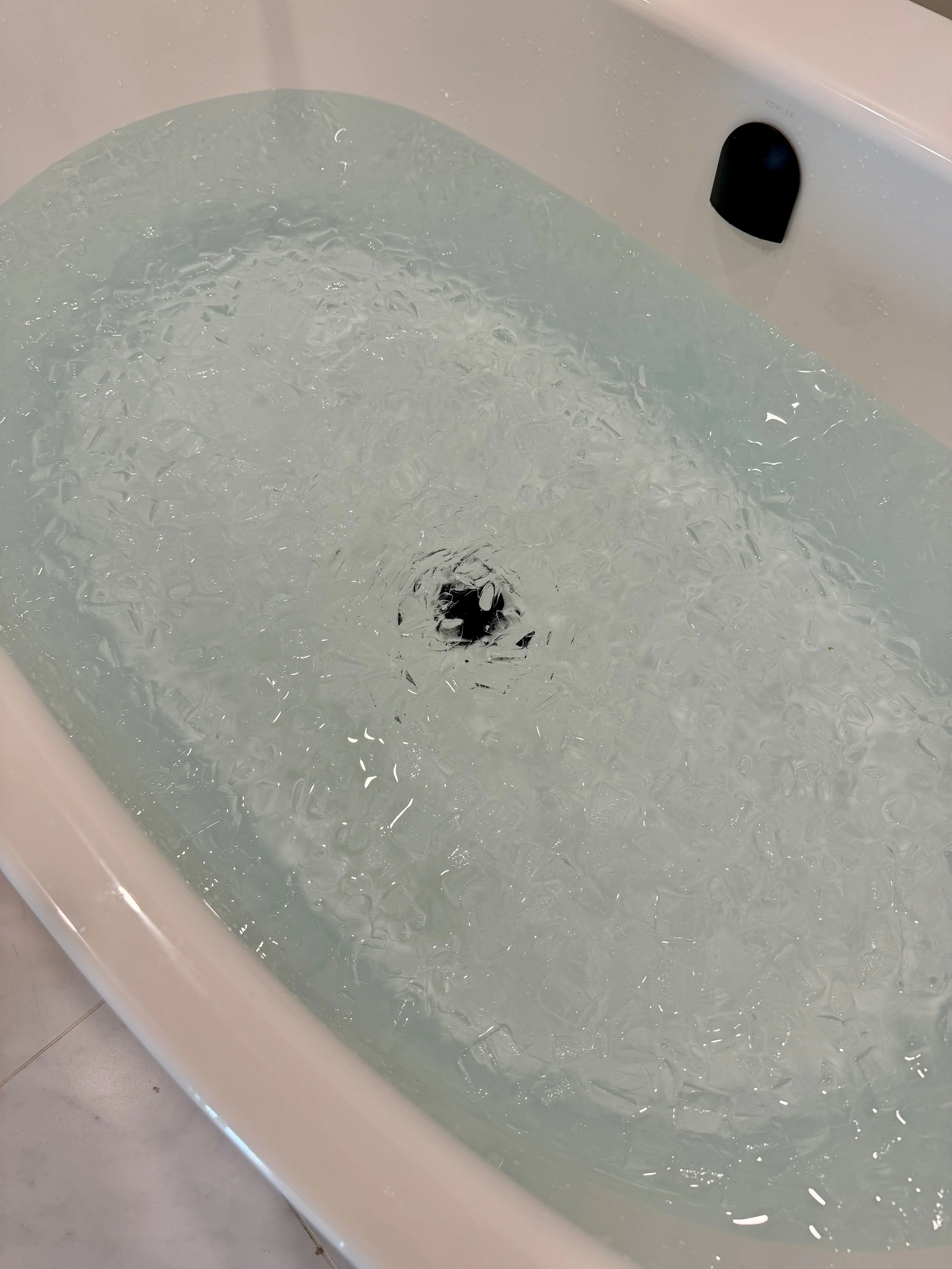Contrast Therapy — Listen to your body (Part 2)
One of the fastest growing areas of fitness over the past few years has been in recovery. Methods that were previously available mostly to professional athletes – or to those who had large budgets for their personal fitness space – are now much more accessible. I wrote about many of these recovery routines in an earlier post, but today, I plan to focus on one in particular that is the staple of my fitness routine – contrast therapy.
Technically, contrast therapy involves two separate recovery methods – hot and cold. The hot usually comes in the form of sauna or steam, while the cold is typically an ice bath (cold plunge) or cryotherapy. What I’ll mainly discuss here is sauna and cold plunge — which is what I do most often.
As I prepared to write this post, I looked back on what my workout routine was before I started contrast therapy versus what it had become afterwards. I knew that much had changed, but I didn’t realize just how big those changes were.
I started contrast therapy in January 2023 — in fact, the wind chill was -7 in New York that day. I had just returned from being away at trial for a week l feeling that I had not approached my wellbeing as well as I could have. I lost the week when it came to getting in workouts, and I spent every day in the red on my WHOOP. So, I came back intent on focusing more on fitness, and I decided to make recovery a big part of that. That freezing day in New York was the first day I walked into Remedy Place for my first ice bath. I’ve been a regular there (and member) since.
For starters, here’s some data as to how my fitness has evolved since I started doing contrast thereapy (along with how many weeks I was away at trial during each year):
2022:
Workouts: 219
Total time: 180:35:00
Won the week: 41 (out of 52)
Weeks away at trial: 1
Average resting heart rate: 74
2023:
Workouts: 291
Total time: 197:10:00
Won the week: 50 (out of 52)
Weeks away at trial: 8
Average resting heart rate: 71
2024 (through September 8 – total of 252 days):
Workouts: 269
Total time: 280:23:00
Won the week: 36 (out of 36)
Weeks away at trial: 5
Average resting heart rate: 66
So much has changed about my routine over the past two years, and the biggest factors driving that change have been due to increased energy and better recovery. Contrast therapy plays a big role in that. Here I will explain both why and how I do it. But first, if you are new to contrast therapy – especially if you have any medical conditions such as a heart condition, diabetes, or high blood pressure – you should consult with a doctor before trying it. Second, whether you are a novice at this or you do it regularly, the number one rule is, listen to your body.
Why I do contrast therapy . . .
The first reason I do contrast therapy is because I find an overall peace of mind when combining two of my favorite recovery routines. Whether I am using the contrast suite at Remedy , or I am switching between sauna and cold plunge at the gym, I use this routine to disconnect. Regardless of how long I spend doing it, which varies, I’ve created a space in my day devoted to clearing my mind and reenergizing my body.
When using the sauna, I will almost always stretch in it, and I often use the rest of the time to meditate. Sure, there are times I stray from the Zen moments and check email or texts, but I try to keep those to a minimum – and even then, I am still getting the benefits of the therapy.
Some of those many benefits include:
Cognitive benefits: both hot and cold release different chemicals in the brain that improve mental function. These various chemicals lead to better memory, improved mood, increased mental focus, and quicker brain function.
Increased energy: Studies have shown that contrast therapy is associated with reduced fatigue and increased motivation.
Reduced muscle soreness: Studies show that contrast therapy is one method for reducing soreness after exercise. It is worth noting that other active recovery methods such as stretching, cold water immersion alone, heat alone, and compression have similar benefits. Contrast therapy is not necessarily superior to any of these methods, but it is one way to achieve these benefits.
Lower inflammation: It’s not surprising that cold therapy is associated with reduced inflammation, but studies have also demonstrated that sauna reduces C-reactive protein levels, a marker for inflammation.
Promotes healing: Heat therapy has been shown to improve circulation which results in faster healing from wounds or injuries.
Weight loss: Studies show sauna is associated with a reduction in body mass, and cold plunge has been linked to possible mechanistic explanations for weight loss.
From personal experience, I’d say that ever since I have been doing contrast therapy, I have more energy, better focus, increased flexibility, and decreased soreness. My fitness gains have happened faster than ever. My weight dropped at a faster pace too. While I don’t attribute most of the weight loss to the direct benefits of the therapy, incorporating contrast therapy into my routine has allowed me to move more, recover faster, and workout harder, all of which increased my weight loss.
How I do contrast therapy . . .
When doing contrast therapy, the most important thing is to listen to your body. My routines vary greatly each time I do it. They range from 15 minutes to about an hour, but what I do during that time, regardless of how long I have, greatly depends on what my body is telling me during the session. Sometimes, 10-15 minutes of sauna is what I can handle. Other times, I can go as long as 30-45 minutes. Similarly, with the cold, there are days when one minute is enough and others where I stay in the tub for six minutes. Depending on who you ask, the maximum recommended time for plunging is anywhere from 6-15 minutes. The key, however, is that greatest benefits come within one minute. Each time I do contrast therapy, I let my body dictate how much longer I go. I also monitor my heart rate data on my WHOOP during the ice bath (watching it lower significantly throughout).
There’s no true right or wrong way to do contrast therapy besides making sure you end with the cold. This ensures the greatest benefits of reducing inflammation, and the body gets the most from plunging when it actively warms itself up afterwards. In fact, when I rotate between hot and cold, I usually wait about three minutes after my plunge to go back into the sauna so that my body warms up on its own.
There’s also some debate about whether to do cold therapy before or after a workout. I believe there are benefits to each. For maximum hypertrophy (muscle growth) after working out, avoid cold plunging for at least four hours post workout. But plunging after a workout provides recovery benefits that keep me fresher for the next one (which leads to more muscle gain in the long run).
There are times that I go to the gym and start right with a cold plunge before working out. The plunge gives me even more energy (on top of the two double espressos I had). After the workout, I stretch in the sauna.
But most of the time, I do my full contrast routine after the workout, getting at least one 10-15-minute sauna and one plunge for 1-5 minutes. If I have time, I’ll repeat that once or twice more.
When I am at Remedy, my happy place, I have a different routine. This is where I truly disconnect. I have a contrast suite to myself for an hour and fifteen minutes which gives more time for relaxation and meditation. In fact, it was while meditating about my journey in the sauna at Remedy that I decided to start Legally Fit. My very first post came to me while in the sauna. Here’s a look at what I’m talking about . . .
These are some of the various routines I do when I use the contrast suite:
Three equal sessions of approximately 14-15 min in sauna, equal sessions of 2-3 minutes in plunge.
Three sauna sessions of decreasing duration starting at 16-18 minutes and ending with 10-12 minutes; plunge after each session in increasing intervals starting with 1-2 minutes and ending with 3-6 minutes (max 9 minutes total plunge).
Two sauna sessions (18-25 minutes each); plunge after each session for 2-6 minutes each (max 9 minutes total plunge).
One long sauna session up to 45 minutes (usually stepping out for a minute or two) and one cold plunge at the end for up to 6 minutes.
If you don’t have access to a sauna, cold plunge, or both, there are other ways to get some form of contrast therapy. Switching from warm-to-cold in the shower is the simplest, and studies have shown health benefits.
Sometimes, my travel schedule for work dictates that hot and cold showering is all I get. But thankfully, contrast therapy is a growing industry, and that has allowed me to work it into even my busiest of times away for work.
When I go away to trial, I find a place to get contrast therapy in on the chance that I get a rare break. A cool spot I found last year in San Diego is, Conscious Body Recovery. Operated out of a private gym, they open at 5 AM and can be booked as late as 8:30 PM, so I had some chances to work it in. It kept me energized, focused, and creative through the late nights.
When I don’t get ice baths in, I notice a difference. So, I have been known to even make them happen on vacations when I am lucky enough to (1) have a bathtub, and (2) get the hotel to deliver coolers of ice. Here’s what I was able to do three days in a row on my golf trip this summer . . .
This coming January, I’ll take my vacation plunging to a new level when I polar plunge in Antarctica like a penguin!
How often I do contrast therapy . . .
Finally, I am often asked how many times a week someone should do contrast therapy. Once again, opinions vary on this, and my routine has varied over time. For sauna, there’s no real limit on how many days to do it, and I sauna nearly every day after working out or before bed. As for ice baths, some say to limit them to twice a week, while others say to do them every day. I started out doing it once a week and soon moved to twice a week. Then when I was comfortable at twice a week, I tried it more often. More often felt even better, and I currently aim to do it about three or four times a week. As you learn your body’s response, find what works for you – but only after consulting your doctor first!
Aaron
For more of my Listen to Your Body series, check out this other post:




